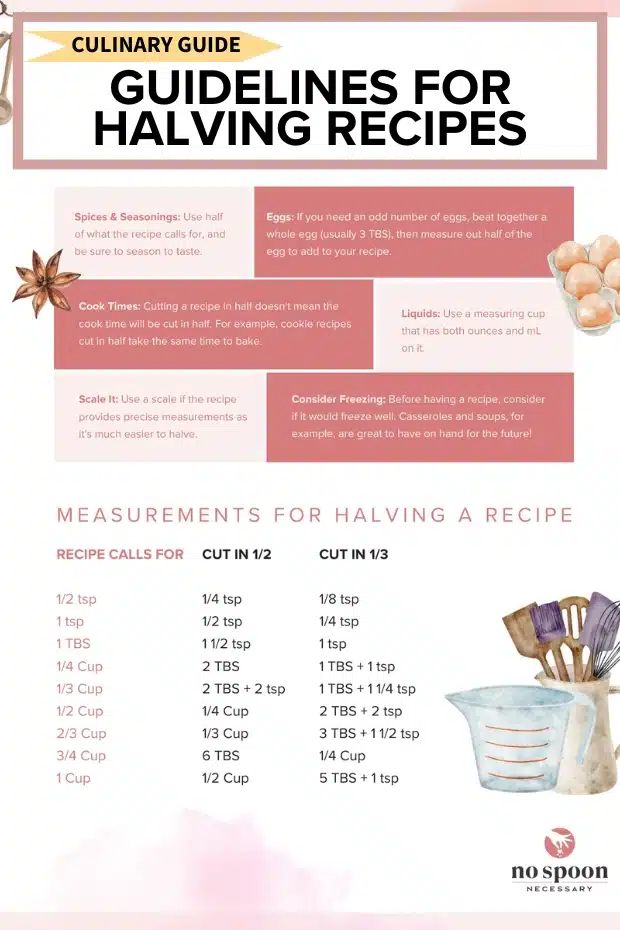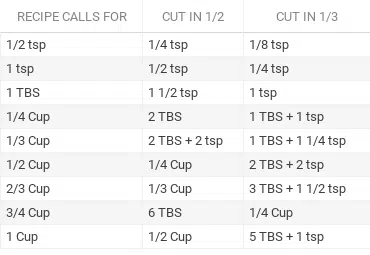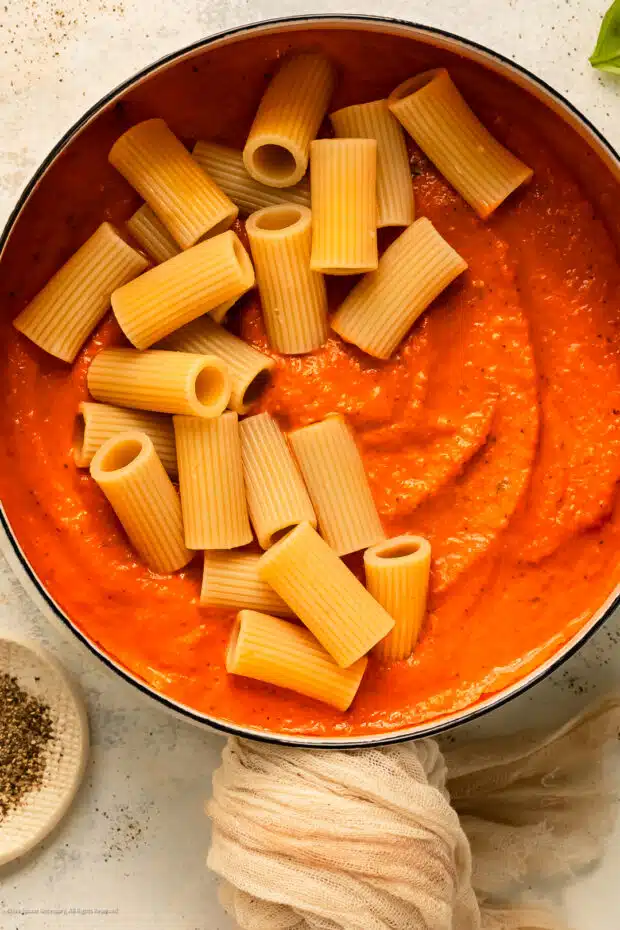This post may include affiliate links. Thank you for your support.
Cutting a recipe in half can be as simple as dividing the ingredient quantities by two. However, if the recipe calls for uneven measurements, such as 1/3 a cup, that calculation isn’t quite as simple. But, don’t sweat it! Simply use these expert tips and handy-dandy, free printable chart showing you how to easily halve recipes and never second guess portion sizes or measurement dividing again!
Table of Contents
How to know if you can cut a recipe in half?
It’s typically safe for home cooks to cut most recipes in half; however, of course there are a few exceptions. For example, baking recipes that use yeast should not be halved.
If you’re unsure whether you can cut a recipe by half or thirds, simply try using the recipe converter provided in most recipe cards, like mine. They’ll automatically scale all the ingredients in the full recipe up or down for you. Then you can just look at the new measurements and easily see if they make sense.
For example, take a tomato soup recipe utilizing a can of San Marzano tomatoes. While you CAN divide that recipe into halves or thirds, you’d be much better off just making the entire recipe and storing your leftovers in the freezer.
Therefore, when it comes to telling if you can cut or multiply a recipe, it’s best to exercise common sense with a little critical thinking.
Things you need to consider before you halve or half a recipe
Before you halve recipes, below is a comprehensive list of everything you should consider doing beforehand.
Cooking times
When it comes to dividing recipes and ingredients, adjusting the cook times can get a little tricky. Simply follow these expert tips to make easy work out of knowing if you’ll need to adjust the cooking time:
- Oven cooking: You won’t need to adjust oven temperatures. However, you may need to adjust your cooking vessels and use smaller pan sizes or skillets. For example, use a smaller baking dish for casseroles. As well, you may need to reduce the cook time by as much as ½ or a 1/3. You’ll need to use your critical thinking skills to assess the recipe and cooking situation, case by case.
- Stove top cooking: You won’t need to change the oven burner setting; however, you may need to size down your sauté pan. As well, you might need to tailor your cook time, depending upon what you’re cooking. For example, searing half a steak will take around the same amount of time as an entire steak. But let’s say you’re reducing a sauce, then you will want to decrease the cooking time.
Converting original measurements into tablespoons and teaspoons
Converting larger measurements, such as ¾ cup, into tablespoons or teaspoons will make easy work out of halving or dividing uneven ingredient measurements. If you refer to this free cooking conversions printable, all the math and hard work is done for you! However, I’ll list the most common measurement conversions here for you to easily reference. (Note: The following conversions are for dry ingredients and dry measuring cups.)
Converting measurements for halving a recipe
Below you’ll find common measurements as well as their conversion and halved measurement:
Dividing measurements
Below you’ll find the halving measurements and third measurements for all cup sizes:
How to halve a recipe
- Convert measurements. To make easy work out of cutting ingredients in half, first convert all larger measurements into smaller measurements. For example, 1/3 cup is equal to 2 tablespoons and 2 teaspoons.
- Calculate the new ingredient amounts. Next, divide each ingredient by two. For example, if the recipe calls for 1 cup of flour, you’ll need .5 cup instead. Or for liquid ingredients, 1 pint divided by two is .5 pint. And, so on.
- Adjust the cooking time. Smaller amounts of food will cook faster than larger ones on the stove top. So, you’ll need to reduce the cooking time by about half to one-third.
- Use smaller cookware. If you’re halving a casserole recipe, you’ll need to use smaller cookware. This is because smaller amounts of food will cook faster in larger cookware. For example, if the original recipe calls for a 9×13-inch baking dish, you’ll need to use an 8×8-inch dish instead.
- Be precise with measurements. When halving ingredients, it’s important to be precise with your measurements. Use a kitchen scale for weighted ingredients, like flour and sugar, and use measuring spoons and cups for wet ingredients, liquids, and fluid ounces.
- Make sure to mix ingredients well. When cutting a recipe, it’s important to mix the ingredients well. This is because smaller amounts of ingredients can be harder to mix than larger ones. Use a whisk or a hand mixer to make sure everything is well combined.
- Don’t forget to taste as you cook. When halving recipes, it’s important to taste the food and adjust the seasonings as you go. This is because the smaller amounts of ingredients can affect the taste of the final dish. Taste the food as you cook it and adjust the salt and pepper as you need.
Expert tips for multiplying and cutting recipes
- Eggs: If you need an odd number of eggs, beat together a whole egg (yolk and white), then measure out half of the egg to add to your recipe. (Tip: A large egg is usually 3 TBS.)
- Spices and Seasoning: When dividing a recipe in half, use half to a little less than half of what the recipe calls for, and be sure to season to taste. When doubling recipes, use a little less than double the ingredients a recipe calls for and season as you go.
- Liquids: To make liquids easier to halve or multiply, use a measuring cup that has both ounces and mL on it.
- Kitchen Scale: If the recipe you are using offers precise measurements in grams, ounces, etc., use a scale to make your life easier.
- Cooking Times: You’ll need to use a little critical thinking when adjusting cooking and baking times, as not every recipe will need adjusting. And cutting a recipe in half doesn’t mean the cook time will be cut in half. For example, cookie recipes cut in half take the same time to bake.
- Consider Freezing: Before having a recipe or cutting it in thirds or fourths, consider if it would freeze well. Casseroles and soups, for example, are great to have on hand for the future!
FAQs: cutting recipe in half
What is half of 1 and a half?
1 ½ divided by 2 is ¾.
What’s half of ¾ cup?
¾ a cup divided by 2 is equal to 6 tablespoons (TBSP or TBS).
Half of 1 ¼ cup is how much?
1.25 cups divided in half is equal to ½ cup plus 2 tablespoons.
Half of ¼ cup?
If you guessed 2 tablespoons based on the above calculation, you would be correct!
What’s 2/3 cup halved?
If you want to cut 2/3 of a cup in half, you’ll need to use 1/3 cup in your recipe.
Divide ¾ cup in half?
¾ of a cup divided by half is 6 tablespoons.
What is half of 1 tablespoon?
Converting a tablespoon into a teaspoon is a very common conversion that I recommend memorizing to make your life in the kitchen easier.
1 tablespoon is equal to 3 teaspoons.
As you can see, knowing this conversion by heart makes easier work out of halving small amounts of ingredients.
Half of 1 tablespoon is equal to 1 ½ teaspoon (tsp).
Half of 3 tablespoons?
3 tablespoons divided into 2 is 1 ½ tablespoons.
What is half of 1 teaspoon?
Half of one teaspoon is ½ teaspoon. And half of a ½ a teaspoon is ¼ a teaspoon, and so one.
1/3 of 2 tablespoons equals how much?
2 tbsp divided into thirds will equal 2 teaspoons.
How do you measure half an egg?
If the original recipe calls for an uneven number of eggs, you may be wondering how to divide thar into halves or thirds. But halving whole eggs is easy! Simply crack your eggs into a liquid measure and whisk the eggs thoroughly together. Then, you can use your eyes to see the precise measurement of the eggs on the glass measure and simply divide that number in half.
Recipes to practice scaling
If you’re wanting to put your math skills to good work, the following recipes are very easy to cut in half, double, or triple:
- How to Whip and Flavor Cream Cheese
- How to Make Garlic Butter and Herb Butter
- Spice Mixes
- Breakfasts: Avocado Toast with Eggs and Cinnamon Sugar Toast
- Appetizers: Phyllo Cup Appetizer, Bacon Deviled Eggs, and Smoked Salmon Rolls with Cream Cheese
- Dips: Whipped Ricotta Cheese and Pico De Gallo Like your Favorite Restaurant
- Soups: White Bean Tuscan Soup and Chickpeas Soup
- Salads: Grilled Peach Burrata Salad and Potato Salad with Herbs
- Side Dishes: Mexican Charro Beans and Zucchini Rice
- Entrée: Greek Shrimp with Tomatoes and Feta and Baked Honey Mustard Chicken
- Snack: Vanilla Peanut Butter Bliss Balls
- Dessert: Mini Apple Pie Bites and Strawberry Sheet Cake (try the sheet cake if you are looking for an advanced recipe to halve.)
- Drinks: Mojito by the Pitchers and Hot Cocoa in the Slow Cooker
Just remember that recipes are like people, some are easier to work with than others. 😉 Also keep in mind that dividing cooking recipes (like soups and entrees) is a pretty easy process; however, you’ll want to use extreme care when shrinking baking recipes, because those are more like scientific formulas than “recipes” per say.
Until next time, cheers!
Cheyanne
Craving MORE? Follow all the deliciousness on Facebook, Pinterest and Instagram!
More culinary guides for better home cooking!
- Tutorial: Stocking Kitchen Cabinets For Easy Home Cooking
- 14 Types of Herbs (and how to cook with them!)
- Best Ways for Storing Fresh Herbs
- Conversion Chart for Baking
- Cooking Temperature Chart for Meats, Poultry, Seafood, and More
- Food Substitutions
- Recipes that Feed a Crowd
Get your free printable here: cutting-recipes
©No Spoon Necessary. All images and content are under copyright protection. Please do not use any images without prior permission. Please do not publish this recipe without prior consent. To reference this recipe, please link directly to this post.







